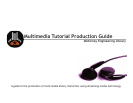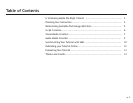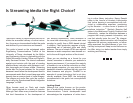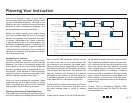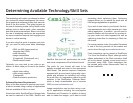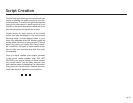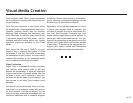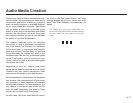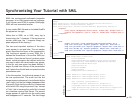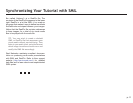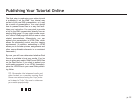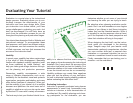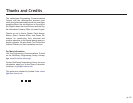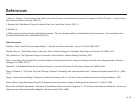
p. 12
p. 12 p. 13
Evaluating Your Tutorial
Evaluation is a crucial step in the instructional
design process. Evaluation allows you to con-
tinuously increase the effectiveness of your
instruction and hone your design skills. Since
your instruction is an online tutorial, you’ll face
unique challenges in evaluating your work—but
don’t be discouraged! You will likely learn as
much from the evaluation process as you did
throughout the planning and production stages.
Your tutorial has elements of both a Website and
instructional material. To accommodate these
dual purposes, we’ll look at two different evalua-
tion processes, one that examines the usability
of Web resources, and one that assesses the
success of the instruction itself.
Usability
In recent years, usability has taken center stage
in the world of Web development. Becoming
familiar with standard usability heuristics (such
as those published by Jakob Nielsen), can
help you make good design decisions through-
out the planning and production processes.
Remember, usability encompasses a wide
range of Website characteristics such as ac-
cessability for the disabled, visual and syntactic
organization, navigation and labeling, and many
other distinct features of interaction. When you
test the usability of your tutorial, do it in multiple
browsers and platforms--the most basic test of
usability is whether or not your site can be seen
by Mac and PC users with a variety of browsers.
The best way to test your nished tutorial for us-
ability is to observe rst-time users navigating
your page or site and accessing the instructional
materials. Don’t worry about the success of the
instruction itself while you test for Usability. First
determine whether or not users understand how
to use the tutorial and can do so successfully.
Usability problems can create false negatives
when you test the efcacy of your instruction;
it’s best to eliminate lingering usability problems
before evaluating the instruction itself.
Evaluating Instruction
Instruction is generally evaluated using learner
assessments of some kind. Assessment may
include an interview, a skills demonstration or
a written test. By carefully planning and choos-
ing participants for the evaluation, you can
determine whether or not users of your tutorial
are learning the skills you are trying to teach.
Be selective when choosing evaluation partici-
pants. Don’t use staff members or even regular
patrons of your library to test library instruction
unless they are the intended learners. While it
is tempting to use the resources close at hand,
you’ll be surprised at the fresh perspective and
ideas that outsiders will bring to the project.
When designing the test itself, use the instruc-
tional goals you developed in the planning
stage. Imagine ways that your learner could
demonstrate newfound competencies; whether
you use a written skills test, a personal dem-
onstration or a personal interview, be sure to
maintain a consistent format for each evaluator.
Finally, remember that you are testing your in-
struction—not the evaluators!
image by freeimages.co.uk



